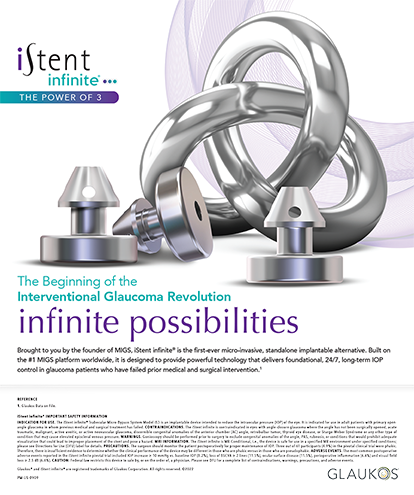Developed especially for custom LASIK, the Allegretto™ excimer laser (WaveLight Laser Technologie AG, Erlangen, Germany) uses ultraviolet light to break up the molecular bonds of corneal cells. With each pass, the beam removes a microscopic layer of the cornea. This process allows light rays to properly focus on the retinal surface inside the eye. Because the Allegretto's™ ultraviolet light beam does not generate heat, it does not cause thermal damage to the targeted corneal tissue, leaving nearby healthy tissue unchanged. The treatment takes only a few minutes, and the correction is permanent. The small diameter of the laser treatment beam, combined with high-speed scanning capability, allows for the correction of spherocylinder refractive errors and higher-order aberrations in a single step.
The Allegretto™ was designed specifically for custom ablation rather than having been adapted for custom ablation. The standard ablation profiles for non–wavefront-guided LASIK procedures are wavefront optimized. For example, as demonstrated by Jack Holladay, MD, if a profile was created with a shot pattern for a myopic correction of -4, the surgeon would first perform wavefront readings on the patient. Next, the surgeon would adjust the profile in order to maintain the natural asphericity of the cornea based on the standardized aspheric program. In other words, the ablation is not tailored to each patient individually, as are wavefront-guided procedures, but takes a standardized coefficient in order to maintain the prolate shape of the cornea.
HOW THE LASER FUNCTIONS WITH WAVEFRONT
The Allegretto™ uses a different aberrometer than do most other laser companies. Both Schwind (Kleinostheim, Germany) and WaveLight use a Tscherning-based aberrometer, and I was initially unsure how the retinal aberrometry would compare to the more classic, outgoing aberrometry that Hartmann-Shack entails. We found it to be highly effective in our practice when used for regular, post-LASIK, and some irregular corneas. In addition, we discovered the refractions to be highly reproducible, and obtained extremely good data compared to some of the other systems that we've used. We were able to obtain readings on about 60% of patients who had postrefractive surgery complications, whereas with Hartmann-Shack, we were only obtaining readings on 10% of those patients. Additionally, with Tracey Technologies' (Bellaire, TX) visual function analyzer that uses the ray-tracing approach, we were able to obtain readings on 100% of irregular corneas and postrefractive surgery complications.
RESULTS
In August of 2001, we started to perform wavefront-guided procedures with the WaveLight Allegretto™. We had completed several hundred cases with Zyoptix™ (Bausch & Lomb, Claremont, CA) the previous year at our clinic in Toronto. It is important to keep in mind that we were not carefully selecting our patients. We took patients with varying degrees of myopia or hyperopia who had large degrees of astigmatism, and treated them as you would in a regular practice with follow-up at 1 day, 1 week, 1 month, 3 months, and 6 months, with cycloplegic refractions and wavefront analysis. We found that by 1 month, 68% of patients had improved best-corrected vision and no patients had lost best-corrected vision. The patients' quality of night vision was superior to what we had previously seen. Intraoperatively, the cornea is maintained in a natural hydration status that allows a more consistent, predictable treatment to be performed. In addition, there is no drying effect to incite edema, epithelial ingrowth, or delayed visual recovery.
When performing a custom ablation, not only are all the regular pulse shots needed for a standard refractive correction, but the surgery also requires additional shots to treat the aberrations that are present in the patients' eyes. The treatments are typically longer, and unless there is a very fast repetition rate, the length of the treatment time increases when handling a large, effective optical zone (typically in the range of one half to 3 minutes per eye). With the Allegretto™ unit, a typical treatment for a moderate myope takes about 40 to 60 seconds, even with an enlarged optical zone. The eyetracker automatically centers on a natural pupil, making the treatment more comfortable for the patient. In our topography, we are obtaining true optical zones of 7 mm, which is not what we have seen with some other lasers, so the actual profile is working as predicted.
IMPRESSIVE REDUCTION OF ABERRATIONS
Postoperatively, we have been able to measure in patients' eyes that the spherical aberration is actually reduced compared to their preoperative values (Figure 1). Considering that a typical non–wavefront-guided procedure usually doubles or triples the amount of spherical aberration measured in the patient's eye, the fact that we have reduced it is impressive—we have been able to reduce coma as well (Figure 2).
Even if the surgeon looks at the higher-order aberrations, he or she is not breaking them down to examine what effect they have on spherical aberration and coma. We have been able to show that we are having a beneficial effect on both of those factors. At our practice, we were not carefully selecting these patients as many other studies do for people who have extremely good best-corrected vision with very low pre-existing aberrations. We were choosing patients at random who had varying degrees of naturally occurring aberrations of the eye with varying degrees of best-corrected vision, and we have been able to demonstrate a significant improvement for a typical patient.
NOT FDA-APPROVED
At this time, the Allegretto™ excimer laser is limited to investigational use only in the US. In terms of wavefront-guided procedures, WaveLight has taken a more conservative approach than other companies. They chose not to begin the trials until they had tried to advance the development of wavefront-guided procedures in international studies to the next level. This is in contrast to other companies that have started FDA trials, and will then need to make adjustments once the trials are concluded to optimize the wavefront patterns that they are utilizing.


